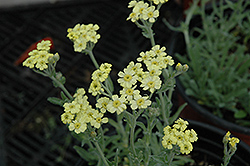>> Home
King Edward Yarrow
Achillea x lewisii 'King Edward'
Height: 8 inches
Spread: 12 inches
Sunlight:
![]()
Hardiness Zone: 3a
Other Names: Dwarf Yarrow
Description:
A low growing, drought tolerant, dwarf selection that features silvery, grey-green foliage and buttery yellow flowers; deadhead to encourage new growth; a wonderful addition to borders, mass planting and fresh cut flower arrangements
Ornamental Features
King Edward Yarrow is covered in stunning buttery yellow flat-top flowers at the ends of the stems from mid spring to early summer. The flowers are excellent for cutting. Its attractive small tomentose ferny leaves remain grayish green in colour throughout the season.
Landscape Attributes
King Edward Yarrow is an herbaceous perennial with a ground-hugging habit of growth. It brings an extremely fine and delicate texture to the garden composition and should be used to full effect.
This is a high maintenance plant that will require regular care and upkeep, and is best cleaned up in early spring before it resumes active growth for the season. It is a good choice for attracting bees, butterflies and hummingbirds to your yard, but is not particularly attractive to deer who tend to leave it alone in favor of tastier treats. Gardeners should be aware of the following characteristic(s) that may warrant special consideration;
- Spreading
- Self-Seeding
King Edward Yarrow is recommended for the following landscape applications;
- Mass Planting
- Rock/Alpine Gardens
- General Garden Use
- Groundcover
- Naturalizing And Woodland Gardens
Planting & Growing
King Edward Yarrow will grow to be about 8 inches tall at maturity, with a spread of 12 inches. It grows at a fast rate, and under ideal conditions can be expected to live for approximately 10 years. As an herbaceous perennial, this plant will usually die back to the crown each winter, and will regrow from the base each spring. Be careful not to disturb the crown in late winter when it may not be readily seen!
This plant should only be grown in full sunlight. It prefers to grow in average to dry locations, and dislikes excessive moisture. It is considered to be drought-tolerant, and thus makes an ideal choice for a low-water garden or xeriscape application. It is not particular as to soil pH, but grows best in poor soils. It is highly tolerant of urban pollution and will even thrive in inner city environments. This particular variety is an interspecific hybrid. It can be propagated by division; however, as a cultivated variety, be aware that it may be subject to certain restrictions or prohibitions on propagation.

